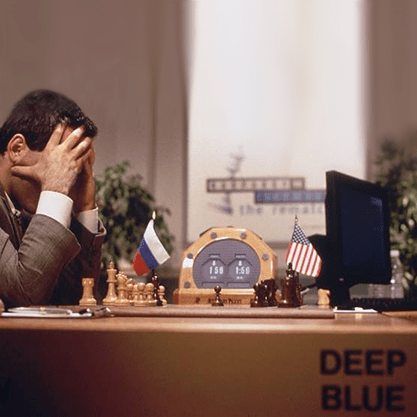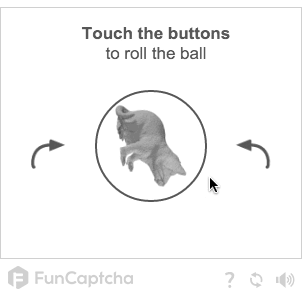One of my favourite games is chess. I am fascinated by the tactics and strategy needed to out-plan your opponent. Naturally, chess is the kind of game we associate with intelligence because it’s about identifying and predicting variables. Chess is logical. It can be programmed. A chess master must always think several moves ahead. So, when Deep Blue — a chess-playing computer — beat grandmaster Garry Kasparov in 1997, it was a sign thatcomputer intelligence had reached a new peak.

© Roger Celestin/Newscom
To say that Deep Blue was intelligent, at least in the same way as Kasparov, is to misunderstand intelligence. There is no reason to believe that Deep Blue has any understanding of chess at all. Much in the same way that an ATM has no knowledge of what a bank is. Your computer doesn’t ‘know’ all your contacts because you keep a file of them, and the bot that beat you in buying concert tickets wasn’t excited to secure such sought-after seats.
Consider John Searle’s Chinese Room experiment. A man sits in a room with a book that provides English translations of Chinese symbols. Then, a piece of paper is slipped under the door containing Chinese symbols. Using the book, the man translates the page of symbols into English and slips the paper back under the door. The system facilitates the translation of Chinese into English, but it cannot be said that the man ‘knows’ Chinese. In a similar way, this demonstrates how a computer can output correct information without having any understanding of what it is doing.
Are we any different? Is there reason to believe that humans are not akin to sophisticated computers, who mimic understanding but don’t really ‘know’ anything? I believe there is an answer to this, and it can be found in an unlikely source: CAPTCHA.
CAPTCHAs are a modern-day Turing test. The Turing test was devised in 1950 by Alan Turing as a way of testing a computer for human-like qualities. Now, we use them to identify humans in online environments. But the question of what separates a human from a computer isn’t just about intelligence. Raw information doesn’t identify humanity any more than Searle’s Chinese Room. I will forever be beaten in chess by my phone because it has far more information about chess than I ever will. Therefore, if a CAPTCHA only checks for a sufficient level of information, a computer will always be able to beat the test. But, my phone will never play chess, because to play requires more than just information.

FunCaptcha Game: Roll the Ball
On the surface, FunCaptcha may appear to operate like other CAPTCHAs: complete a quick task to verify you are a legitimate user. However, those tasks are generally grounded in identification — What is 2+2? What is this word? How many cars are in this photo? When you examine FunCaptcha more closely, you’ll find it operates very differently: play a quick game. Now, the game itself is undeniably simple for humans, and yet completely enigmatic for computers. It doesn’t test an ability to regurgitate information, as in the Chinese Room experiment. It tests a sophisticated understanding of an object within a certain context.
In one game, FunCaptcha asks the user to rotate an image of a 3D model until it is the ‘right’ way up. Each image is generated in real-time from the 3D model with the angle, lighting, texture, and other key variables randomly manipulated. Consider a horse is a shown. As a human, I can identify a horse immediately, or at very least, understand how a four-legged animal should look when standing. A computer, however, ‘sees’ things differently. For a computer to identify the image as a horse, it needs other similar images of horses to compare it to. It needs a database, much like the book of symbols in the Chinese Room. Except, by design, no image is presented in FunCaptcha the same way twice. In fact, each 3D model — of which there are endless supply — creates millions of unique combinations of the same image.

Each 3D model creates millions of unique images
The success of this approach highlights a human quality that is yet to be replicated in a computer. It’s a kind of human understanding that goes beyond a database of collected and curated information. It demonstrates how humans process and understand the world as we ‘see’ it, but computers cannot. A computer collects a visual input, identifies similarities to other inputs, and then declares what it ‘knows’. Whereas a human can see, and understand, what they know.
How, then, does play factor in?
Let’s revisit chess. Computers can be programmed to beat even the most talented human opponents, and yet never actually play chess. Play is an attitude, or a way of understanding something. People have any number of reasons for participating in an activity — “I get paid to do it”, “I need to do it to survive” or “I do it for someone” are common explanations. But playful activities are different. We generally only play games, build sand castles, or dance, because we want to. There is some fundamental value that we have found in these specific activities that compels us to act. This intrinsic self-motivation is the playful attitude made manifest. In the absence of a playful attitude, we can engage in the activity of chess, building sand castles, or dancing…but it’s likely that we would simply give up without any other reason to complete them. Certainly, if dancing was the only way to deactivate a bomb, there would be a discrete reason to do it.
In that scenario, a person would not be playing. The playful attitude — and the activity that is made possible by it — are two different things. A computer, however, would continue to engage in that activity. It’s not motivated to complete the activity based on some love for it, or a desire to win. It keeps going because it is programmed to do so.
Now, CAPTCHA is by no means an autotelic activity. It is an interstice between our motivation and the associated payoff. An interstice that was traditionally designed to obfuscate information from computers; ultimately at the expense of human understanding. We saw this interstice as an opportunity to appeal to users’ playful, and uniquely human, understanding.
Understanding that transcends rule-based data and taps into how humans process the world. After all, “Whoever wants to understand much must play much.” — Gottfried Benn

